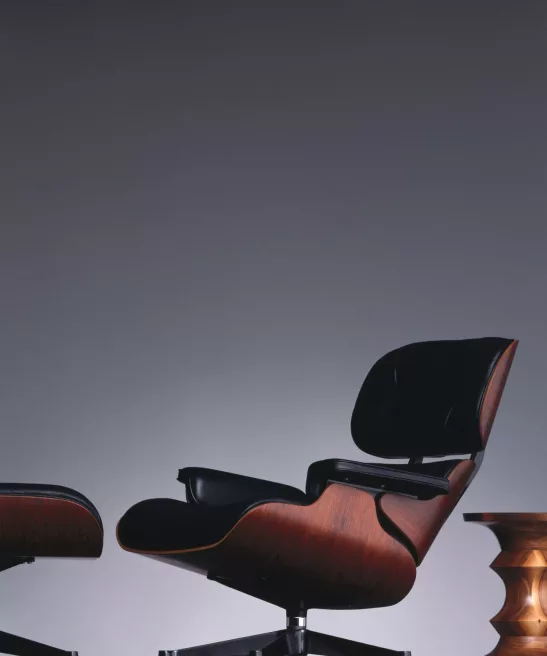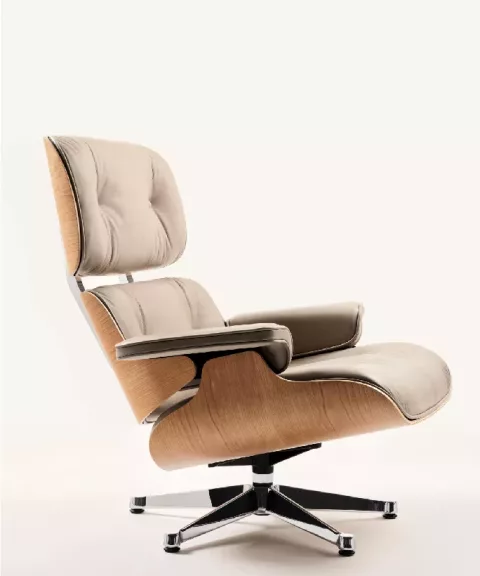Born in 1907 in Saint Louis, Missouri, Charles Eames studied architecture at Washington University in Saint Louis and designed a number of houses and churches in collaboration with various partners. His work caught the attention of Eliel Saarinen, who offered him a scholarship to the Cranbrook Academy of Art in Michigan in 1938. In 1940, he and Eero Saarinen won first place in the “Industrial Design Competition for the 21 American Republics” – also known as “Organic Design in Home Furnishings” – organised by the Museum of Modern Art (MoMA) in New York. During the same year, Charles Eames became director of the industrial design department at Cranbrook.
Born Bernice Alexandra Kaiser in 1912 in Sacramento, California, Ray Eames studied painting at Bennett College in Millbrook, New York. Until 1937, she continued her studies in painting at the Hans Hofmann School of Fine Arts. During this year, she participated in the first exhibition of the group American Abstract Artists at the Riverside Museum in New York. She enrolled at the Cranbrook Academy of Art in 1940.
Charles and Ray Eames married in 1941 and moved to Los Angeles where they began experimenting together with three-dimensional plywood moulding techniques. The goal was to create comfortable and affordable chairs.
However, the war interrupted their work and Charles and Ray turned instead to the design and development of plywood splints, which were manufactured in large quantities for the United States Navy. In 1946, they exhibited their experimental furniture creations at the MoMA. The Herman Miller company in Zeeland, Michigan then began to produce Eames furniture.
In 1948, Charles and Ray entered MoMA’s “Low-Cost Furniture” competition, and in 1949, they designed the Eames House as their private residence. In addition to their work in the field of furniture design and architecture, they also regularly dabbled in graphic design, photography, filmmaking and exhibitions.


Endowed with a strong sense of adventure, Charles and Ray Eames converted their curiosity and boundless enthusiasm into creations that made them a formidable design couple. Their incomparable synergy gave rise to a new look in furniture. Clean and contemporary. Fun and functional. Sleek, sophisticated and beautifully simple. This was, and still is, “the Eames look”.
This “look” was born towards the end of the 1940s, with moulded plywood seats, including the “lounge chair”, famous throughout the world and now part of the permanent collection of the Museum of Modern Art in New York.
The considerable success of Charles and Ray Eames is due to the fact that they approached each project in the same way: does it interest and intrigue us? Can we improve it? Are we really going to enjoy working on it?
Furniture by Charles and Ray Eames has been one of the cornerstones of the Vitra Design Museum collection since its inception. The museum obtained much of the items from the couple’s estate in 1988.
After presenting the exhibition “The Work of Charles and Ray Eames” in 1997-98, the Vitra Design Museum is devoting an extensive retrospective to the universal work of the couple in 2017-18, entitled “An Eames Celebration” and consisting of four parallel exhibitions on the Vitra Campus in Weil am Rhein.
On this occasion, the Vitra Design Museum has published the books “Eames Furniture Sourcebook” and “Essential Eames: Words & Pictures”.
The role of the designer is that of an excellent, attentive host who anticipates the needs of his guests.
I think the most difficult thing is to keep in mind the general idea, to be able to look critically at the work.
